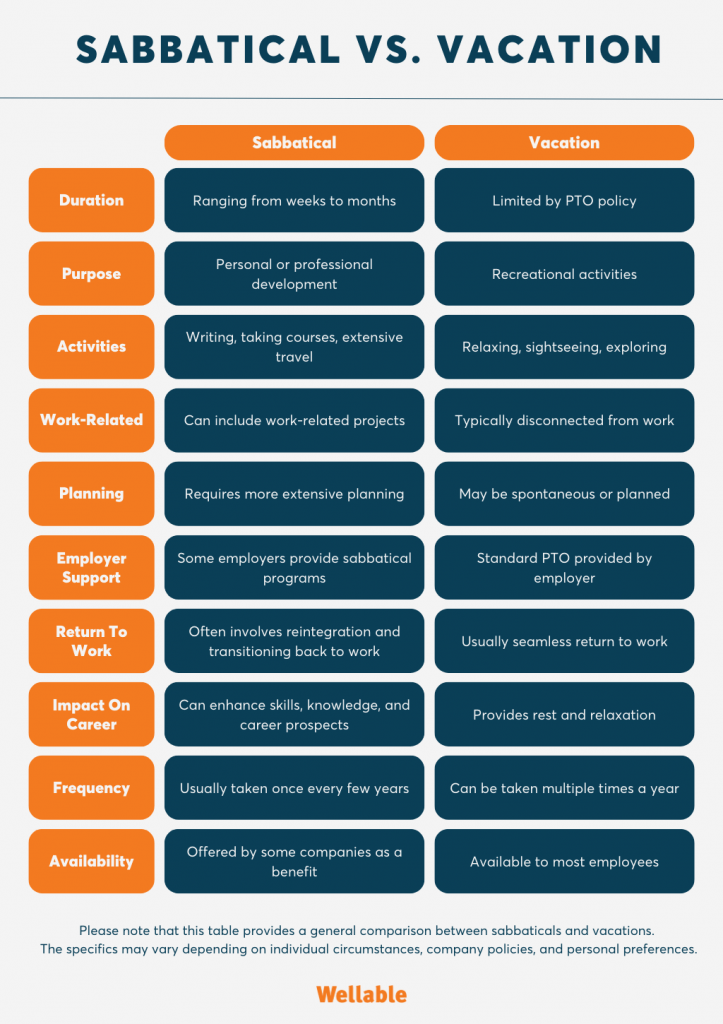In the quest for work-life balance to battle burnout, organizations may unintentionally overlook a valuable employee benefit: sabbatical leave.
Rather than resorting to quitting or retiring, or settling for a brief two-week vacation, what if employees had the opportunity to extend their time off from work, returning refreshed, reinvigorated, and inspired?
This article covers the definition, current landscape, and benefits of sabbaticals, strategies for addressing the associated stigma, and best practices for implementing sabbatical programs.
Pressed for time? Here’s a quick summary…
- Sabbatical leave is an extended hiatus from work, ranging from several weeks to several years, intended for professional growth or personal enrichment.
- Sabbaticals have numerous benefits, from enhanced well-being and job satisfaction to increasing employee retention and engagement.
- In the US, employees may fear the stigmatization associated with taking sabbatical leave, so organizations must foster a work environment that accepts career breaks as a natural part of one’s professional journey.
- For a sabbatical to be successful, organizations must establish clear sabbatical leave criteria and conditions and make adequate preparations for an employee’s absence to maximize the leave’s benefits and ensure smooth business operations.
What Are Paid Sabbaticals?
Sabbatical leave is an extended period of time off work, ranging from several weeks to several years, depending on the company’s policy and the employee’s tenure. The reasons for taking a sabbatical may vary, including:
- Exploring personal interests;
- Pursuing professional development opportunities;
- Spending extended time with family;
- Travelling the world; or,
- Volunteering.
While not required, a sabbatical is traditionally paid time off, ensuring employees fully reap the benefits of enhanced well-being without the burden of financial stress.
A sabbatical differs from vacation time in the following ways:
- Sabbaticals are longer than vacations, exceeding traditional PTO limitations.
- Sabbaticals commonly focus on personal or professional development, while vacations are often recreational.
- Sabbaticals enable activities that are difficult to pursue while working full-time, such as writing, taking courses, or extensive travel.

Paid Sabbaticals: The Current Landscape
While sabbaticals are a long-standing tradition in academia, their adoption within the business world has been comparatively slow. Still, their presence has witnessed an upswing, with 11% of employers offering unpaid sabbaticals and 5% offering paid sabbaticals, according to the Society for Human Resource Management. This is a significant increase since 1977, when McDonald’s pioneered what was considered the first corporate sabbatical program in the US.

Recent corporate trends reveal continued growth in the number of employers offering sabbaticals:
- In 2020, Citi announced that employees with 5 years’ tenure could take up to 12 weeks of sabbatical, receiving 25% of their base pay during their time off.
- Last year, Goldman Sachs introduced a six-week unpaid sabbatical for employees with 15 years or more of service.
- Other companies like Blue Cross Blue Shield, Whole Foods, Zillow, and Patagonia, to name a few, also embrace sabbaticals. Bank of America is the latest major player to join this movement. Starting next year, the corporation will offer paid four-week sabbaticals to employees who have dedicated 15 years to the company. Longer-tenured Bank of America employees in Charlotte, North Carolina will receive an increased sabbatical period: five weeks for 20 to 25 years of service, and six weeks for 30 years or more. Employees can take two paid sabbaticals throughout their careers in addition to regular vacation days.
This new program replaces Bank of America’s previous sabbatical policy, which provided a four-week break only to employees in the company’s global banking and markets division after 10 years of service. By expanding the eligibility criteria and enhancing the benefits, the bank is demonstrating a stronger commitment to supporting employees’ well-being and personal growth.
Your emotional wellness matters and is an essential component of your overall health. Sabbaticals are meant to help employees reinvest in their priorities in life.
Bank of America
Time has emerged as one of the most coveted employee benefits. As more companies adopt this trend, it indicates an ongoing shift toward prioritizing employees’ well-being and work-life balance, recognizing that happy and fulfilled employees are more likely to be engaged and committed.
Benefits Of Offering Paid Sabbaticals
Offering paid sabbaticals comes with a range of benefits for both employees and the organization. These advantages highlight why this trend has been gaining traction in the business world. Implementing a paid sabbatical program can result in:
- Enhanced Well-Being: Paid sabbaticals promote overall well-being by allowing employees to invest in personal aspirations without the burden of financial strain.
- Increased Employee Retention: Paid sabbaticals are a valuable retention tool, showcasing a commitment to work-life balance.
- Improved Employee Engagement: Opportunities for personal enrichment contribute to higher engagement as employees return to work with renewed passion.
- Heightened Job Satisfaction: Employees experience greater job satisfaction when their company demonstrates support for their aspirations outside of work.
- Elevated Creativity & Innovation: Extended time off work inspires fresh perspectives and ideas, fueling creativity and innovation within the workforce.
- Reduced Burnout: Granting time off to recharge combats burnout and boosts overall productivity.
Addressing The Stigma Of Taking A Sabbatical
Despite the numerous benefits of sabbaticals, many US employees fear stigmatization due to the entrenched “hustle culture” often associated with Silicon Valley. This culture sharply contrasts from other regions like Europe, where ample vacation time and holidays are a commonplace and free from social judgment. While unused PTO days are rare in Europe, they are often worn as a badge of honor in the US.
Taking a sabbatical is not the kind of thing that super-engaged executives do.
Peter Cappelli, Director of the Wharton School’s Center for Human Resources
To combat this fear and optimize sabbatical leaves—or any time off for that matter—there must be a profound shift in the way Americans perceive work and rest. This transformation must be spearheaded by US organizations themselves, as they have the power to set the standard of work-life balance for their employees.
Normalize Employment Breaks

By recognizing career breaks as a natural part of one’s professional journey, employers can dismantle the stigma associated with periods of rest and gaps in resumes. This empowers individuals to confidently re-enter the workforce, enriched by the skills and experiences they’ve gained during their time away. More than just accepting, actively normalizing employment breaks promotes work-life balance and personal well-being, while diminishing fear of criticism or retribution.
Half of the battle is believing that you are worthy of a season of rest and deconstructing guilt and fear of judgment
CEO of a company that provides work for marginalized communities in Afghanistan, anonymous due to the dangerous nature of their work
Encouraging time off allows organizations to access a talent pool enriched with unique perspectives, renewed energy, and untapped potential, fueling a vibrant and innovative work culture.
Share Success Stories
Celebrating individuals who have embraced time off and re-entered the workforce highlights an organization’s support for employees’ well-being and self-discovery journeys. Testimonials can encourage others to pursue similar opportunities. The following is an example of a testimonial by Kate Gillette Horne, Customer Success Manager at HubSpot:
There are so many directions you can take for your sabbatical and the best direction to go can also be very dependent on your current lifestyle and living situation. My husband and I threw around a ton of ideas as there are many things on my bucket list, but we also had a baby that was about to turn one and no local family (or any that would take a baby for over two weeks).
Traveling the coast of California was always on our list, and we decided that option would be very baby-friendly. Preparation at work was fairly easy because my team has a customer facing team alias for emergencies, which we can put in our out-of-office. So during any time out of office, the team picks up your slack and you pick up their slack when they are out.
The great thing about HubSpot is that since everyone has the opportunity to take a sabbatical (and any vacation), no one minds helping out and supporting the current person who’s out, so I never felt like I was burdening anyone and also don’t feel like it’s a burden to support others who are out — which makes the month off 10x better. The only major source of stress of the whole process was making sure I picked the absolute best path up the coast.
Kate Gillette Horne, Customer Success Manager at HubSpot
Paid Sabbaticals Best Practices For Employers

There are no legal requirements or regulations to offer sabbaticals. However, it’s best to establish clear criteria and conditions for this type of leave to avoid misunderstandings, including:
- Eligibility;
- Whether or not the leave is paid;
- Maximum duration of the leave;
- Approval process; and,
- Purpose of the policy, which should align with the company’s culture and mission.
A team’s functioning should not depend on one individual, so it’s necessary to prepare for unexpected or long-term absences to ensure smooth business operations. This involves determining how the absent employee’s responsibilities will be handled, whether by redistributing tasks or hiring a temporary replacement. If the employee serves as a client’s point of contact, sufficient time should be allocated to introduce the replacement to the client.
By setting clear expectations and making adequate preparations, employees can fully embrace their sabbatical leave without concerns, maximizing the benefits for both individuals and the organization.












